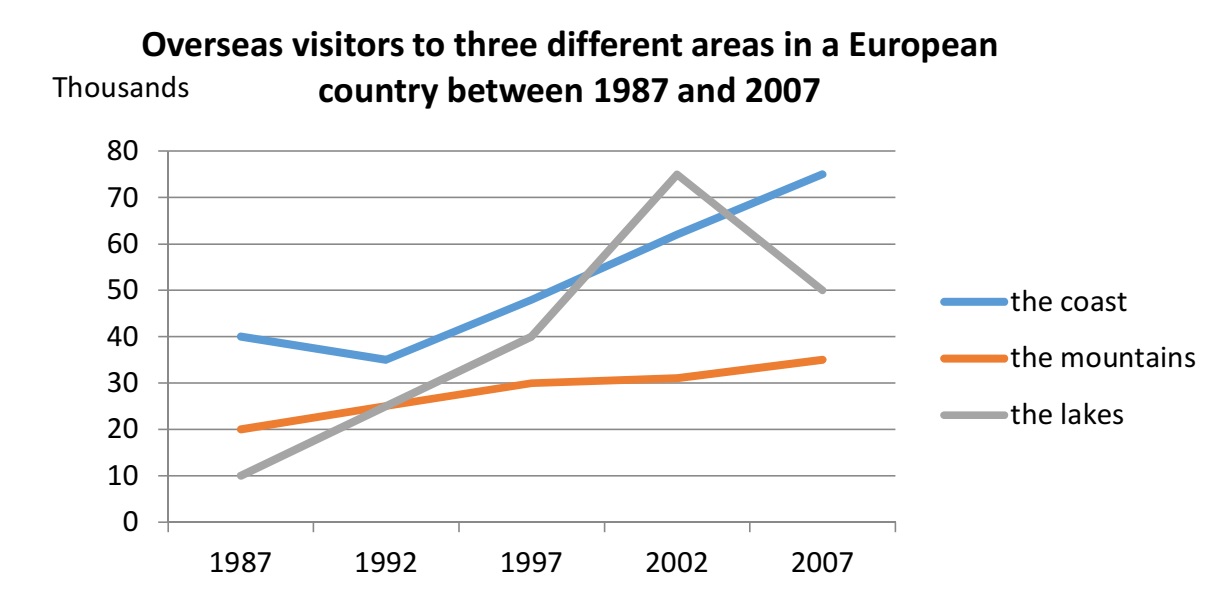The graph below shows the number of overseas visitors to three different areas in a European country between 1987 and 2007.
Write at least 150 words.

The users of social media, such as Facebook, Twitter, are replacing face-to-face contact in this century.
Do you think the advantages of this way outweigh the disadvantages?
Give reasons for your answer and include any relevant examples from your own knowledge or experience.
Write at least 250 words.
WRITING TASK 1
The given line graph depicts information about how many foreigners visited three separate regions in a European nation, during the span of a 20-year period from 1987 to 2007.
Overall, the most notable detail is that those three regions all attracted an increasing number of foreigners. In addition, the lakes’ tourist figures witnessed the most dramatic change among those given.
In more detail, at approximately 10,000 visitors in 1987, the quantity of foreign travelers who were attracted to the lakes gradually rose to around 50,000 in 2000, before peaking at approximately 75,000 tourists in 2002, This figure then dropped back down to approximately 50,000 people in 2007.
With regards to tourist numbers in coastal and mountainous areas, the overall figures increased, however mountainous areas remained the least attractive travel option out of the three. In 1987, the number of those who chose the coast as a travel destination stood at 40,000, compared to only 20,000 travelers who went to the mountains. In the next 14 years, the coast witnessed a slight decrease in the quantity of visitors by a few thousand, which was followed by a significant climb to around 60,000 people, whereas the number of those visiting mountainous areas went up remarkably to 30,000 in 2001.
In the final 6 years, while the quantity of overseas tourists going to the coast rose moderately to above 70,000, there was a slight climb in those who paid a visit to the mountains to about 35,000.
(244 words)
WRITING TASK 2
It is claimed that modern technological tools for communication, including social media, are gradually replacing direct contact among people. From my perspective, the drawbacks of this trend totally overshadow its merits.
To begin with, it is true that the emergence of social networking websites and applications such as Facebook have revolutionized the way people contact one another. To be more specific, nowadays, regardless of geographical distance, people from most places on the planet can send messages or make use of video calls to keep in touch with their loved ones, eliminating the need for people to gather in one place for face-to-face conversations. In terms of business, thanks to the invention of online-based communication tools, including Facebook and Viber, people working in enterprises can conduct their meetings via the internet, also eliminating the need for people to be in the one place to conduct a meeting. As a result, face-to-face conversations are gradually being replaced by virtual communication exchanges.
However, the aforementioned merits are totally eclipsed by the potential negative drawbacks of this trend. Firstly, in this technological era, with the development of online communication tools, it can be seen that many people are substituting their real-life relations with digital communication. In fact, a large number of young people nowadays tend to prefer making friends via means of social media, such as Facebook and Twitter, to gathering at a real place. In the long term, this would gradually alienate people from communities, which could even lead to social isolation and a lack of many interpersonal skills. Secondly, literacy skills of many people could also be negatively affected due to the lack of social interaction and ways to transmit formal messages. It is true that most individuals, especially teenagers, often use informal language with several emoticons when communicating on social networking. Consequently, their ability to read and write in situations that require formality is greatly reduced.
In conclusion, although social media has brought some benefits for society, the drawbacks of overusing such advanced technology to replace real-life communication is much more significant.
(305 words)
